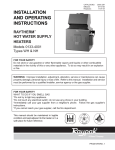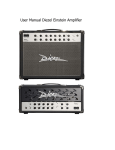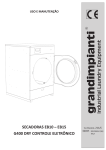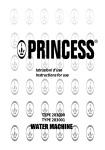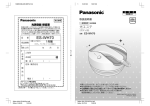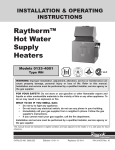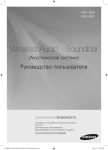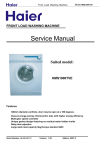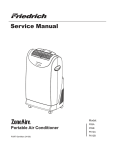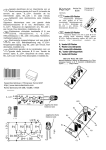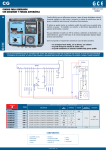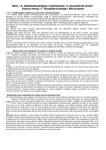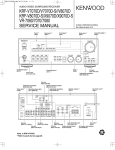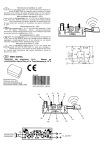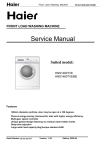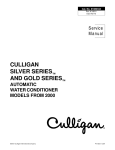Download Identificazione. Specifica del prodotto. Definizioni. Preparazione del
Transcript
Identification. Product specification. Definitions. Preparation of the product for use. WF8-11-18-22-33-40-55G400 & G400M Manual Manufactured on the basis of EN 62079:2002-01 – EN 60204-1 Keep for future consultation. MA_B008_WF8-11-18-22-33-40-55G400_Chap 1-5_rev.00 30/03/2011 1 Index 1. SUMMARY..............................................................................................................4 1.1 KEY OF INDICATIONS...................................................................................... 4 DOCUMENT RELEASE.............................................................................................. 4 2. IDENTIFICATION....................................................................................................5 2.1 APPLIANCE MARK AND DESIGNATION OF THE TYPE............................................. 5 2.2 APPLIANCE VERSION....................................................................................... 5 2.3 NAME AND ADDRESS OF THE PRODUCER, SUPPLIER AND DISTRIBUTOR................ 6 2.4 PICK-UP AND DELIVERY OF THE APPLIANCE BY THE CARRIER............................... 6 3. PRODUCT SPECIFICATION.......................................................................................8 3.1 GENERAL FUNCTIONS AND RANGE OF APPLICATIONS, DECLARED USE................... 8 3.2 DIMENSIONS AND WEIGHTS (FOR TRANSPORT).................................................. 9 3.3 SUPPLY DATA REGARDING ELECTRICITY, GAS, WATER AND OTHER CONSUMABLES..10 3.4 ENERGY CONSUMPTION, CONDITIONS............................................................. 11 3.5 NOISE EMISSIONS, WASTE, ETC..................................................................... 11 3.6 IP CODE....................................................................................................... 12 3.7 ENVIRONMENT CONDITION AND FUNCTIONING AND STORAGE LIMITS (TRANSPORT) 12 3.8 INFORMATION RELATIVE TO SAFETY, SUMMARY (PERSONAL PROTECTION, NON-DECLARED USE)............................................................................................... 13 THE USE OF ANY ELECTRIC OR ELECTRONIC APPLIANCE MEANS SEVERAL FUNDAMENTAL RULES MUST BE COMPLIED WITH........................................................................... 13 3.8.1INFORMATION REGARDING RESIDUAL RISKS................................................ 15 4. DEFINITIONS.......................................................................................................18 4.1 SYMBOLS (LABELS) APPLIED TO THE APPLIANCE............................................... 19 5. PREPARATION OF THE PRODUCT FOR USE...............................................................21 5.1 TRANSPORT AND STORAGE............................................................................ 21 5.2 SAFETY PRECAUTIONS BEFORE USE................................................................ 22 5.3 UNPACKING.................................................................................................. 22 5.4 SAFE DISPOSAL OF PACKAGING MATERIALS..................................................... 23 5.5 PREPARATION WORK BEFORE INSTALLATION.................................................... 23 CHECK THE SUPPLY ACCOMPANYING THE APPLIANCE............................................... 25 5.6 INSTALLATION AND ASSEMBLY....................................................................... 26 TO OPEN THE FRONT PANEL IN ALL APPLIANCE MODELS........................................... 26 TO OPEN THE UPPER PANELS IN MODELS KG 8, KG 11, KG 18 AND KG 22................... 27 TO OPEN THE FRONT PANELS IN MODELS KG 33 G400, KG 40 G400, KG 55 G400........ 28 TO OPEN THE REAR PANELS IN ALL APPLIANCE MODELS........................................... 29 TO REMOVE THE RIGHT AND LEFT SIDE PANELS IN MODELS 22 G400, KG 33 G400, KG 40 G400, KG 55 G400............................................................................................... 29 5.6.1MASONRY WORK........................................................................................ 30 5.6.2WATER CONNECTION................................................................................. 31 5.6.3STEAM AND CONDENSATE CONNECTION (ONLY FOR APPLIANCES WITH STEAM HEATING)................................................................................................. 33 5.6.4DRAIN PIPE CONNECTION........................................................................... 35 5.6.5ELECTRIC CONNECTIONS............................................................................ 36 PARTICULARITY OF THE ELECTRIC CONNECTION IN THE KG 8 G400, KG 11 G400, KG 18 G400, KG 22 G400 MODELS.................................................................................. 38 5.7 REMOVAL OF THE TRANSPORT BRACKETS........................................................ 38 5.8 REGULATION OF UNBALANCING MICRO SWITCH ON ALL MODELS....................... 40 OPEN THE UPPER PANELS IN KG 8, KG 11, KG 18 AND KG 22 MODELS........................ 40 5.9 AIR-BREAK................................................................................................... 41 5.10VENTILATION................................................................................................ 42 5.11ERGONOMIC INSTALLATION OF THE APPLIANCES.............................................. 42 5.12INSPECTION................................................................................................. 43 2 5.13STORAGE AND PROTECTION DURING INTERVALS BETWEEN NORMAL USE ........... 44 5.14RE-PACKAGING TO PREVENT DAMAGE DURING TRANSPORT .............................. 44 5.15ATTRIBUTION OF THE INFORMATION (USERS, OPERATORS, MAINTENANCE EXPERTS) 44 5.15.1 LOCATION OF THE INSTRUCTIONS............................................................ 44 5.16WARRANTY................................................................................................... 45 Translation of the original instructions. For any claims or observations the reference text is the original one in the manufacturer's language i.e. Italian. 3 1.SUMMARY 1.1KEY OF INDICATIONS Attention! • Indicates a procedure of a functioning, assembly or verification condition which, if not complied with, can cause death or injury/ damage to persons, animals and objects. Attention! • Indicates a procedure or functioning, assembly or verification condition which, if not complied with, can cause damage or destruction of the appliance or the components of which it is composed. • Indicates a procedure or functioning condition, the compliance with which, as well as being restrictive, can optimise working, realisations or assembly of the component/s in question in these instructions. This manual supplies the instructions for transport, installation, functioning and maintenance of the following appliance models: • kg 8 G400 - G400M • kg 11 G400 - G400M • kg 18 G400 - G400M • kg 22 G400M • kg 33 G400M • kg 40 G400M • kg 55 G400M DOCUMENT RELEASE Ver 00 Document name WF G400 use and installation manual Network archiving address I:\110_PROGETTI\P-12_G400_Abilitazione programmazione\P12-54Documentazione-Manuali-Schemi\ Manuale secondo EN 22079_2002-1\ MA_B008_WF8-11-18-22-33-4455_CAP1-5_rev.02.docx Author Date G.G. 29/06/10 This manual has been drawn-up in compliance with the following Standards: • • • • • • • • • IEC EN 62079:2002-01 EN 62017 EN 60204-1 chapter 17 EN 60335-1 from chapter 7.12 EN 60335-2-7 chapter 7 (and integrations A1, etc. ) ISO 12100-2 ISO 10472-1 ISO 10472-2 ISO 9398-4:2003 4 Aprvd. Date 2.IDENTIFICATION Check that the appliance that has been delivered corresponds with the model stated on the transport document, invoice. The model is stated on the label positioned on the packaging, as well as on the rear closing panel of the appliance. 2.1APPLIANCE MARK AND DESIGNATION OF THE TYPE Check that theappliance model stated on thelabel is the same described in the transport document and/or invoice. Model Figure 2 Plate positioned on the appliance. Figure 2 Plate positioned on the packaging. 2.2APPLIANCE VERSION The appliance version is always stated in the “model” field stated on thepackaging label and the appliance, and is characterised as follows: WFJ XX G4 Y/Y ZZZZ: Code Value WF J High spin speed appliances (extraction factor at maximum speed > 350 G). M --XX G4 Y/Y With G400M processor that can be programmed from the keyboard. With standard G400 microprocessor, programmable only via personal computer or smart card. Appliance (8, 11, 18, 22, 33, 40, 55). G400 or G400M electronic programmer E Appliances without heating (functioning with hot water) or with electric heating. V Appliance with direct steam heating. E/V VI ZZZZ Description Appliance with mixed electric and direct steam heating (with selector switch). Appliance with indirect steam heating. GETT Appliance intended for self-service use (coin operated, automatic launderettes). --- Appliance intended for standard use. 5 Gives the possibility to have the following combinations: WF8G4 WF11G4 WF18G4 WFM22G4 WFM33G4 WFM40G4 WFM55G4 WFM8G4 WFM11G4 WFM18G4 WH70 WH100 WH180 WH220 WH330 WH400 WH550 2.3 NAME AND ADDRESS OF THE PRODUCER, SUPPLIER AND DISTRIBUTOR Manufacturer: • • • • • • Name: Grandimpianti Industrial Laundry Equipment ALI S.p.A. Address: via Masiere 211/c, 32037 Sospirolo (BL) Italy Tel: +39 (0) 437 848 711 Fax: +39 (0) 437 879 108 E-mail: [email protected] WEB: www.grandimpianti.com Supplier (importer):............ IMPORTER STAMP............... Distributor:........................ DISTRIBUTOR STAMP.......... 2.4 PICK-UP AND DELIVERY OF THE APPLIANCE BY THE CARRIER Attention! • Before accepting the appliance from the carrier, check the conditions of the packaging. If this is evidently damaged on the outside, the appliance may have undergone consequences. In this case, unpack the appliance in the presence of the carrier and sign the relative transport document with reserve. 6 • • Any damage due to transport or incorrect storage cannot be blamed on the appliance manufacturer. Given the wooden cage packaging on the kg 33 G400, kg 40 G400, kg 55 G400 model, check that the parts projecting, e.g. dispenser drawer, door handle, isolator switch, etc have not been damaged. Declaration of Conformity in compliance with product Standards 7 3.PRODUCT SPECIFICATION 3.1 GENERAL FUNCTIONS AND RANGE OF APPLICATIONS, DECLARED USE We would like to thank you for the purchase of our appliance. We are sure you will be satisfied and will obtain the best guarantees if you follow the indications given in this manual carefully. We would like to inform you that the text to make reference to for any claims or observations, is that in Italian. Read the content of this manual thoroughly and keep it with the appliance. It must be easily accessible. The recommendations and warnings contained in this manual cannot cover all eventualities, it is important to have common sense, attention and prudence. These are features that the manufacturer cannot add to the machine but must be envisioned by the persons carrying out installation, maintenance and/or using the appliance. In the event of interventions on the appliance, the manufacturer recommends the use of original spare parts, which must be ordered after consultation of the technical attachment. Attention! • Any person using this appliance must read this user manual. The descriptions and illustrations contained in this manual are not binding; the company therefore reserves the right, at any time and without forewarning, to update the publication and/or make any modifications to parts, components and accessories, if this is deemed necessary for improvement or any construction or sales character. Attention! • All other use that is not explicitly indicated must be considered dangerous. • The manufacturer cannot be considered liable for any damage deriving from improper, incorrect or unreasonable use or however not stated in this manual. • This appliance is not intended for use by children or persons with reduced physical, sensory or mental capabilities, unless they are supervised by a person responsible for their safety. • Modifications of the electric, electronic or mechanical components and also to their relative positions can only be made after written authorisation from the manufacturer. • Children must be controlled so that they do not play with the appliance. 8 3.2 DIMENSIONS AND WEIGHTS (FOR TRANSPORT) If the appliance must be transported and/or delivered the following recommendations must be followed: • only use the original or similar bed. • use the manual or electric lifting truck with sufficient lifting capacity and fork length (see table and fig. 3). • check that the appliance can exceed all obstacles e.g. stairs, doors etc. • use the original packaging if the appliance must be shipped. The product must be stored in closed environment, protected against atmospheric agents. Appliance model Gross weight (kg) Width* (mm) Depth* (mm) Height* (mm) Forks minimum length X (mm) Kg8 G400 – G400M 250 750 850 1240 1100 Kg11 G400 – G400M 300 750 930 1290 1100 Kg18 G400 – G400M 485 930 1140 1510 1100 kg22 - G400M 830 975 1190 1620 1100 Kg33 - G400M 1370 1430 1475 2105 1500 Kg40 - G400M 1700 1430 1570 2105 1500 Kg55 - G400M 1770 1430 1750 2105 1500 (*) measurements of the packaged appliance. Figure 3 Appliance transport. 9 3.3 SUPPLY DATA REGARDING ELECTRICITY, GAS, WATER AND OTHER CONSUMABLES. The appliance is set-up with 3 water supply connections, one electric power supply input and one steam supply input (for the appliances envisioned with this type of heating). The inputs are displayed in the figure and the dimensions for the connections are stated in the table. A B, C, D A B, C, D A E F Appliance model A, input electric power supply B, hard cold water inlet C, soft cold water inlet D, hot water inlet E, steam inlet F, water drain Kg8 G400 – G400M Kg11 G400 – G400M 3/4” Kg18 G400 – G400M 3” kg22 - G400M Kg33 - G400M Kg40 - G400M 1” Kg55 - G400M 10 3/4” 3.4 ENERGY CONSUMPTION, CONDITIONS Current absorption, hourly steam consumption and water consumption for the different appliances. Appliance model Type of heating Electric absorption (Kw) Electric 6.75 Steam 0.75 Electric 10.5 Steam 1.5 Electric 14.2 Steam 2.2 Electric 24 Steam 3 Electric 28 Steam 4 Electric 43.5 (opt. 24) Steam 7.5 Electric 43.5 (opt. 24) Steam 7.5 Kg8 G400 – G400M Kg11 G400 – G400M Kg18 G400 – G400M kg22 - G400M Kg33 - G400M Kg40 - G400M Kg55 - G400M Steam consumption (Kg/h) 7.2 9.5 18 45.8 150 170 170 Total water consumption (litres) Hot water only consumption (litres) 79 (**) 18 (**) 113 (**) 23 (**) 137 (**) 40 (**) 152 (**) 45 (**) 340 (**) 110 (**) 540 (**) 125 (**) 684 (**) 140 (**) Consumption calculated on the basis of the ISO 9398-4:2003 Standard. Data relative to soap consumption are not supplied as the amount of soap depends on different factors such as: supplier, type, hardness of the water available in the network, amount of laundry loaded, options selected (e.g. ECO selection). 3.5 NOISE EMISSIONS, WASTE, ETC. Noise values of the different appliances. Appliance model Noise dB (A) kg 8 – 11 – 18 – 22 G400 – G400M < 70 kg 33 – 40 - 55 G400M < 77 Attention! • During its functioning, the appliance generates water containing soap/s as well as "dirt" removed from the laundry. • The manufacturer cannot be held responsible regarding the quality and quantity of this waste. • Follow the local and national Standards in force regarding the disposal of this waste. 11 3.6 IP CODE IP codes relative to each appliance model and the descriptions of the code itself. Appliance model IP protection rating Description IP 24 D Appliance not protected against mechanical blows. Protected against sprays of water inclined to 15°. kg 8 G400 – G400M kg 11 G400 – G400M kg 18 G400 – G400M kg 22 G400M kg 33 G400M kg 40 G400M kg 55 G400M 3.7 ENVIRONMENT CONDITION AND FUNCTIONING AND STORAGE LIMITS (TRANSPORT) Attention! • The appliance is suitable only for use in CLOSED ENVIRONMENTS. • In the event of long permanence in the deposit, leave the appliance inside its original packaging, which guarantees excellent protection. • In the event of long standstill periods, after the appliance has been used, follow the instructions given in paragraph 5.7. Minimum and maximum environmental conditions for functioning. Functioning conditions Electric power supply Model All models Water pressure (KPa) Steam pressure* Room temperature (°C) Relative room humidity (%) V Hz Min Max Min (Kpa) Max (KPa) Min Max Min Max -10 < V < +10 of the value stated on the label ±1 with respect to the value stated on the label 100 800 50 600 5 35 30 without condensation 90 without condensation * (only for appliances with this type of heating) Minimum and maximum environmental conditions for storage and transport of the appliances. Model Functioning conditions Room temperature (°C) All models Min. 0 Room relative humidity (%) Max. Min. Max. 55 0 without condensation 90 without condensation 12 3.8 INFORMATION RELATIVE TO SAFETY, SUMMARY (PERSONAL PROTECTION, NON-DECLARED USE) Attention! • This paragraph states all conditions and behaviour for preventing dangerous conditions for persons, animals, objects or the environment. • Read that stated thoroughly and keep this manual near to the appliance for easy consultation! • The appliance must only be used by trained persons. In the event of breakdown and/or malfunctioning: • disconnect the plug from the socket (if envisioned). • close the interlocked switch padlock • close the loading gate valve cocks (hard cold water, hot hard load, steam and and steam condensate draining if present) • empty the dispenser from any soap product residues. During use, cleaning and maintenance, attention must be paid not to access moving parts with tools or the hands (motors, fans). In the event of accidents, the manufacturer does not assume any liability for damage to theoperator or other persons taking place duringuse, cleaning and maintenance of the appliance. Do not open the soap drawer when the appliance is functioning (boiling water or soap may be sprayed pushed by the water pressure). The appliance has been designed to treat textiles according to the indications stated on the labels of the garments themselves. Only treat garments, household linens and fabrics for everyday use. Do not handle items that have been in contact with inflammable chemical materials. Hand wash first and dry them in the airto make these substances evaporate completely . In particular: THE USE OF ANY ELECTRIC OR ELECTRONIC APPLIANCE MEANS SEVERAL FUNDAMENTAL RULES MUST BE COMPLIED WITH. • • • • • • • Do not touch the appliance with wet or humid hands or feet. Do not use the appliance barefoot. Do not leave the appliance exposed to atmospheric agents (rain, salt, sea salt etc.). Do not allow children to use the appliance or unable persons to use the appliance without suitable surveillance. Do not smoke in proximity of the appliance during use. Do not remove or by-pass safety devices. Never use direct or indirect jets of water on the appliance, pay attention not to install it in proximity of zones where this is possible. 13 • Do not touch water or steam pipes even if the appliance is not running. • Do not wash garments in the appliance, which have the "hand wash" label or relative symbol. • Do not use hypochlorite, which could cause the oxidation of some parts of the appliance (whether electric, electronic or metal). • Incorrect concentrations of soaps or additives used during the washing phases can reduce the life span of the appliance and its performance. Attention! • The manufacturer is not liable for damage to fabrics washed using an inappropriate program or soap. • The manufacturer is not liable for the lack of respect of indications present on the labels of the garments to be handled or on the soaps or additives. • If the labels on the appliance become illegible, replace them. • The manufacturer is not liable for labels that have been removed or replaced. • Respect all local laws relative to safety. Attention! • The isolating switch input contacts are always live even if the switch is in the off position! • The electric connection and especially the earth wire connection must be made and checked by authorised staff in compliance with the local Reference Standards. • The appliance must have a permanent connection to the earth clamp and the equipotential clamp must be connected with other appliances present in the same place. • The appliance must not be installed on a wooden floor even if it is reinforced. • The floor of the premises where this appliance is installed requires the approval of a structural engineer, who checks the feasibility depending on the static and dynamic load data supplied by the appliance manufacturer. • Do not use the appliance if parts do not function or have been removed. • If the plastic membrane positioned on the appliance control keys is damaged-broken do not use the appliance. Replace the damaged membrane. • If the appliance is not used for 2 weeks or more, it is normal that hydrogen forms in the hot water piping. This highly explosive gas, must be removed by opening the hot water piping for a few minutes. During this operation, there must not be any naked flames present in the room. • Perform maintenance with the regularity requested in this manual. • If body parts should come into contact with the liquid leaking from a damaged display unit, wash using soap and water. Seek medical help in the event of accidental ingestion. • Do not use the appliance if you are not trained to do so. 14 3.8.1 INFORMATION REGARDING RESIDUAL RISKS Attention! • Shearing and burns hazard. Do not introduce the hands or objects into the tub-dispenser connection pipe or into the protection for airing the inverter. Attention! • Shearing hazard. Do not introduce hands or objects between the fixed and floating parts of the appliance. 15 Attention! • Burns hazard. The appliance door glass can reach temperatures of 80 ÷ 90°C (depending on the washing cycle selected). Attention! • Burns hazard. Steam may escape from the appliance dispenser drawer and the air-break device. Pay attention to the temperature of the same. Do not introduce hands or objects through these devices. 16 Attention! • Burns hazard. The steam intake pipe A, that of the condensate drain B, the hot water intake pipe C and drain D can reach high temperatures. • The steam intake and condensate drain pipes must be appropriately isolated and protected. C D A B Attention! • Fire hazard. Do not perform the spin cycle with a load of dry laundry. 17 4.DEFINITIONS To help understanding of the manual regarding uncommon definitions, below find the definitions and synonyms of some words used. Appliance = product subject of the manual (washing machine in this case). User = person that: • • • • • Is assigned to use the appliance. Has read and understood all pertinent parts of the manual in question. Is able to perform routine maintenance and clean the appliance. Is assigned to extraordinary maintenance of the appliance. It is a qualified person, as expressed successively. Weighing = washing cycle phase used to identify the weight expressed of the load introduced into the drum in kg. This phase is composed of 2 distribution ramps. (for kg 8 G400 , kg 11 G400 , kg 18 G400 , kg 22 G400 and relative M versions only). Soak = washing cycle phase necessary to loosen stubborn dirt to be removed from the fabric. Prewash = washing cycle phase necessary to loosen and remove dirt of organic nature. Wash = main phase of the washing cycle necessary to remove dirt from the fabric. Rinse = phase of the washing cycle necessary to remove the soap and dirt is suspension from the fabric. Spin = phase of the washing cycle necessary to remove dirt and soap from the fabric. Un rolling = final phase of the washing cycle necessary to detach the laundry from the drum and the final spin. Protection = part of an appliance used specifically to supply a guard by means of a physical barrier. Damage = physical wounding, damage to health of persons, deterioration of assets or the environment. Danger = potential source of damage. Protection device = safeguard (different to a protection) which reduces the risk (mechanical or electric devices). Risk = combination of the probability of damage occurring and seriousness of the same. Informed person = person suitably informed or monitored by a trained person in a way to allow them to perceive risks and prevent dangers, created potentially by functioning or maintenance of the appliance. Qualified technician = person with training, knowledge and experience such to allow the perception of risks and prevent dangers that can derive from interactionwith the appliance. 18 4.1 SYMBOLS (LABELS) APPLIED TO THE APPLIANCE Description Symbol Description At the end of its useful life, the product must be collected separately from other waste. Conformity mark on the product in compliance with CE Standards. Attention, electric hazard: disconnect the appliance from the mains before any intervention. Attention, crushing hazard: Only use original spare parts. When repairs and maintenance have been completed, restore all panels in their original position. Greasing the bearings is mandatory at every indication on the display. Attention, read the instructions! Appliance safety earth connection. Attention, electric hazard: disconnect the appliance from the mains before any intervention. Equipotential connection. Appliance earth connection. Burns hazard. Burns hazard. Attention, electric hazard, voltage 400Vac Room installation and ventilation requisites. 19 Symbol Description Symbol Description Capacity of the fuses on the appliance. Electric master switch High pressure steam. Programming n° tokens in the appliance envisioned for self-service functioning. Explanatory text. N° of copies present in the appliance and positioning. Slot for insertion of the smart card in the relevant reader. Optional. Explanatory text. N° of copies present in the appliance and positioning. Smart card reader. Optional. 20 Symbol 5.PREPARATION OF THE PRODUCT FOR USE 5.1 TRANSPORT AND STORAGE Attention! • Check that the appliance has correct space necessary for use and functioning of the same according to the installation layouts. • See technical attachment relative to the layouts. Proceed as follows if the appliance must betransported and/or shipped: • Use the original bed. • Use the manual or electric lifting truck with sufficient lifting capacity and fork length. • Check that the appliance can exceed all obstacles e.g. stairs, doors etc. • Use the original packaging if the appliance must be shipped. • The product must be stored in closed environment, protected against atmospheric agents. Appliance model Gross weight (kg) Width* (mm) Depth* (mm) Height* (mm) Forks minimum length X (mm) Kg 8 G400 – G400M 250 750 850 1240 1100 Kg 11 G400 – G400M 300 750 930 1290 1100 Kg 18 G400 – G400M 485 930 1140 1510 1100 kg22 - G400M 830 975 1190 1620 1100 Kg33 - G400M 1370 1430 1475 2105 1500 Kg40 - G400M 1700 1430 1570 2105 1500 Kg55 - G400M 1770 1430 1750 2105 1500 (*) measurements of the NON-packaged appliance. Figure 4 Dimension of the forks for transport using fork lift truck. 21 5.2 SAFETY PRECAUTIONS BEFORE USE Attention! • The following conditions must be verified before installation and use of the appliance: {{ {{ {{ {{ {{ The transit zones of the appliance to reach the place to be used must at least support the static load of the appliance and transport system. The floor where the appliance will be installed must resist the dynamic load and the static load generated by the appliance. Wooden floors are not allowed for installation of the appliance. Check that the electric absorption of the appliance is lower than the availability supplied by the electrical energy body. Check that the water and steam pressures available (for appliances envisioned with this type of heating) is within the accepted values. Model Static load (N) Dynamic load Electric absorption Kw (value for version with steam heating) KG 8 G400 2840 2330 ±730N, 16 Hz 6,75 (0,75) KG 11 G400 3330 2740 ±1100N, 16 HZ 10,5 (1,5) KG 18 G400 5830 4660 ±1,220N, 16 HZ 14,2 (2,2) KG 22 G400 8080 6452 ±1,626N, 15 HZ 23 (3) KG 33 G400 14416 12709 ±2,747N, 14 Hz 24 (4) KG 40 G400 18162 16083 ±2,943N, 14 Hz 43.5 opt. 24 (7,5) KG 55 G400 19574 17064 ±3,139N, 14 Hz 43.5 opt. 24 (7,5) Max. water pressure (KPa) Max. steam pressure (KPa) 800 600 5.3 UNPACKING Remove the packaging: • Cut the straps that fix the cardboard (kg 8 G400, kg 11 G400, kg 18 G400, kg 22 G400) and lift upwards. • Remove the sides of the wooden cage (kg 33 G400, kg 40 G400, kg 55 G400). • After removal of the external packaging, remove the nylon bag. Attention! • Put the packaging material in a safe place and that is not accessible to unauthorised persons. 22 5.4 SAFE DISPOSAL OF PACKAGING MATERIALS The following materials are used for packaging: • Nylon (for the bag). • Cardboard (for the box, for kg 8 G400, kg 11 G400, kg 18 G400, kg 22 G400 only). • Wood (for the bed on all appliances and wooden cage for kg 33 G400, kg 40 G400, kg 55 G400 only). If the materials used for packaging must be disposed of, they must be taken to a waste collection and disposal centre. The adequate separate collection of the packing for the successive start-up of the appliance to be re-cycled, treatment and environmentally compatible disposal contributes to preventing possible negative effects on the environment and favours the re-cycling of materials that make up the packaging itself. Abusive disposal of the packaging by the user leads to the application of administrative sanctions envisioned by the Standards in force. Refer to the WEEE European Directive regarding the recovery of parts (only for countries that are part of the European Community). If it possible to dismantle the individual parts and take them to a differentiated collection centre, refer to the cataloguing groups of the individual parts. If required, the cataloguing groups can be found in the website: www.euwas.org 5.5 PREPARATION WORK BEFORE INSTALLATION When the packaging has been removed, check the data stated on the appliance identification plate. kg 33 G400 kg 40 G400 kg 55 G400 kg 22 G400 Figure 5 Rear view. Positioning the identification plate. 23 kg 8 G400 kg 11 G400 kg 18 G400 Company name Model Motor power Serial number IP protection rating of the appliance Power Supply Voltage Year and month of production Appliance typeapprovals. Total electric absorption Total power Figure 6 Identification plate present on the last page of the manual and on the rear panel of the appliance. Company name Model Serial number Power supply voltage and frequency Lord weight and dimensions Net weight and packaging volume Quality control performed signature Inspector's signature Figure 7 Identification plate present on the appliance packaging. Attention! • Do not power the appliances with voltages and frequencies outside of the values stated. • Check that the electric power supply data correspond with the electric energy supply values. 24 CHECK THE SUPPLY ACCOMPANYING THE APPLIANCE The following supplies, as per standard, must be found inside the drum. These depend on the type of appliance and the heating source envisioned. Open the door and control according to the list given. Model Standard supply Additional supply only for appliances with steam heating. Optional supply 2 (4 for indirect steam) ¾’’ high temperature gaskets for steam pipe fitting, 1 steam filter with ¾’’ connections, 1 (2 for indirect steam) flexible hose for steam fitting with ¾’’ lock-nut, 1 (2 for indirect steam) piece of Teflon braiding to isolate the steam pipe. 15 tokens for self service appliances supplied with electro-mechanical coin operation. kg 8 G400 kg 11 G400 1 exploded diagrams manual to be considered an integral part of this manual, 1 90° rubber 3’ diameter elbow joint, 2 straps for fixing the rubber hose, 3 water loading pipes with ¾’ lock-nut, 4 x M10 plugs to fix the appliance to the floor. kg 18 G400 1 exploded diagrams manual to be considered an integral part of this manual, 1 90° rubber 3’ diameter elbow joint, 2 straps for fixing the rubber hose, 3 water loading pipes with ¾’ lock-nut, 4 x M10 plugs to fix the appliance to the floor, 1 set of spanners for opening appliance lid. kg 22 G400 1 exploded diagrams manual to be considered an integral part of this manual, 1 90° rubber 3” diameter elbow joint, 2 straps for fixing the rubber hose, 3 water loading pipes with ¾” lock-nut, 4 x M10 plugs to fix the appliance to the floor, 1 set of spanners for opening appliance lid. 2 (4 for indirect steam) ¾’’ high temperature gaskets for steam pipe fitting, 1 steam filter with ¾’’ connections, 1 (2 for indirect steam) flexible hose for steam fitting with ¾’’ lock-nut, 1 (2 for indirect steam) piece of Teflon braiding to isolate the steam pipe. 1 exploded diagrams manual to be considered an integral part of this manual, 1 90° rubber 3” diameter elbow joint, 2 straps for fixing the rubber hose, 3 water loading pipes with 1” lock-nut,3 x 1" water load filters, 4 x M16 plugs to fix the appliance to the floor, 1 set of spanners for opening appliance control panel, 1 rubber elbow with diameter of 60 mm for vent fitting. 2 (4 for indirect steam) ¾’’ high temperature gaskets for steam pipe fitting, 1 steam filter with ¾’’ connections, 1 (2 for indirect steam) flexible hose for steam fitting with ¾’’ lock-nut, 1 (2 for indirect steam) piece of Teflon braiding to isolate the steam pipe. kg 33 G400 kg 40 G400 kg 55 G400 25 5.6 INSTALLATION AND ASSEMBLY The following materials are used for packaging: • Remove the lower front service panel (all models, fixed with 2 – 4 cross head screws). • Open the upper panel of the kg 8 G400, kg 11 G400, kg 18 G400, kg 22 G400 models, following the instructions given below. • Open the control panel of the KG 33 G400, KG 40 G400, KG 55 G400 models, making reference to the figures shown below. • Remove the lower rear panel in all models. • Remove the central rear panel on 22 G400, KG 33 G400, KG 40 G400, KG 55 G400 models. • Remove the right and left side panels for KG 33 G400, KG 40 G400, KG 55 G400, all fixed with 2 cross-head screws at the top and 2 hex-head bolts in the lower part. • Remove the bed, which is fixed using 4 bolts on the same holes to then be used to fix the appliance to the floor. TO OPEN THE FRONT PANEL IN ALL APPLIANCE MODELS kg 33 G400 kg 40 G400 kg 55 G400 kg 8 G400 kg 11 G400 kg 18 G400 kg 22 G400 Figure 8 Open the lower front panel on all models. 26 OPEN THE UPPER PANELS IN MODELS KG 8, KG 11, KG 18 AND KG 22 1) Remove the 4 cross-head steel screws positioned under the rubber lid of the soap drawer. 3) Lift the lid by a few centimetres in the rear part until it passes the edge of the upper back piece and then push forward. 2) Remove the 2 bolts that fix the lid to the upper back piece. Figure 9 upper panel opening in models kg 8 G400 and kg 11 G400. 1) Remove the 4 crosshead steel screws positioned under the rubber lid of the soap drawer. 3) Insert the key (horizontal) and turn anticlockwise. 2) Insert the key (horizontal) and turn anti-clockwise 4) Hold the keys 1 and 2, turn and push the lid firmly upwards. Figure 10 upper panel opening in models kg 18 G400 and kg 22 G400. 27 Release the rod and move it upwards. Insert the end point in the relevant hole on the lid. Figure 11 Positioning the upper panel support rod in the kg 18 G400 and kg 22 G400 models. TO OPEN THE FRONT PANELS IN MODELS KG 33 G400, KG 40 G400, KG 55 G400 Open the door of the control panel (for KG 33 G400, KG 40 G400, KG 55 G400 only), introducing the supplied keys into the relevant locks and turning both anti-clockwise. Turn the panel downwards, accompanying it with the hands. 2) Insert the key (horizontal) and turn clockwise. 1) Insert the key (horizontal) and turn anticlockwise. 3) Keep the keys in open position and lower the lid. Figure 12 Opening the control panel. 28 TO OPEN THE REAR PANELS IN ALL APPLIANCE MODELS kg 33 G400 kg 40 G400 kg 55 G400 kg 22 G400 kg 8 G400 kg 11 G400 kg 18 G400 Figure 13 Remove the rear panels from the appliance. TO REMOVE THE RIGHT AND LEFT SIDE PANELS IN MODELS 22 G400, KG 33 G400, KG 40 G400, KG 55 G400 Figure 14 Remove the side panels. Operate on the upper and lower screws as described. 29 5.6.1 MASONRY Attention! • The appliances must be positioned on a flat, level and solid surface. • Consult the technical attachment regarding the distances to respect between the appliances and between these and the masonry. • Wet or humid floors require the appliance to be fixed using the relevant plugs. • Check that the pressure ÷ weight is equally distributed on the entire support surface. The appliance may have to be fixed to the floor or not, depending on the model and type of floor. • kg 18 G400, kg 22 G400, kg 33 G400, kg 40 G400, kg 55 G400 • must be fixed to the floor using the supplied plugs. If this prescription is not followed, the appliance can move and cause injury/damage to persons,animals and objects. kg 8 G400 and kg 11 G400 are fitted with rubber feet and are designed to work without being fixed via plugs. In this case, the floor must have a coefficient of friction greater than 0.5 (adimensional value). In the event of a floor with lower coefficient of friction, these appliance models must also be fixed to the floor using the plugs supplied. To fix to the floor, make holes with suitable diameter depending on the measurements present in the installation layouts given in the technical attachment. Check that the appliance is level. Regulate the feet (kg 8 G400 and kg 11 G400 only) positioned on al corners of the appliance or place shims between the base of the appliance and the floor (kg 18 G400, kg 22 G400, kg 33 G400, kg 40 G400, kg 55 G400 only). Block the feet using a counter-nut in appliances fitted with feet, when the same has been levelled. If the appliance must be moved, perform levelling and fixing again. The tightness of the floor screws for kg 22 G400, kg 33 G400, kg 40 G400 and kg 55 G400 must be measured using a dynamometric wrench. 30 1. M8 screw 2. M8 safety nut 3. M8 nut 4. Machine chassis 5. Washer 6. Eventual raised chassis 7. Concrete floor 8. Anchorage bolt 9. Supplied plug 9 4 Load capacity 8 kg 11 kg 18 kg 22 kg 33 kg 40 kg X7 mm 40 60 X8 mm 150 160 55 kg 5.6.2 WATER CONNECTION The appliances are set-up for on hot water inlet (max. 90°C) and two cold water inlets, respectively hard and soft. See paragraph 3.3. Using the table given it is possible to determine the hardness of the water according to the most used units of measurement . Classification mmol/dm3 °dH (German degrees) °fH (French degrees) English degrees Soft 0→1,25 0→7 0→12 0→8,75 Medium 1,25→2,5 7→14 12→25 8,75→17,5 Hard 2,5→3,75 14→21 25→37 17,5→26,3 Very hard >3,75 >21 >37 >26,3 Set-up the wall gate valves at a distance that does not exceed the length of the pipes supplied. Attention! • If soft hot or cold water is not available, set-up on or two "T" connections in a way to always supply all inlets present on the appliance. The average consumption of hot and cold water (total between hard and soft) is given in the table in paragraph 3.4. 31 Attention! • Do not connect the water inputs with rigid pipes. • Only use the supplied pipes. • Rigid piping is an origin of problems due to the vibrations generated by the appliance during normal functioning. • The KG 8 G400, KG 11 G400, KG 18 G400 and KG 22 G400 model appliances have plastic water supply connections: follow the procedure below for correct closure of the flexible hose lock-nut. {{ Tighten the nut manually. {{ Make a quarter of a turn with a face spanner. • When assembly has been completed, check that there is no narrowing or crushing of the hoses used. Figure 15 kg 8 G400, kg 11 G400, kg 18 G400, kg 22 G400 models water connection 32 M Figure 16 kg 33 G400, kg 40 G400, kg 55 G400 models water connection Place the filters indicated with the letter M in the figure, between the water supply pipe and the load electrovalves. Ca be found among the appliance suppliesinside the drum. Attention! • To check the correct tightness of the load pipe lock-nuts and the filters where present, open the water gate valve slowly and check for the presence of leaks. • If leaks should occur, close the lock-nut further and check again. 5.6.3 STEAM AND CONDENSATE CONNECTION (ONLY FOR APPLIANCES WITH STEAM HEATING) The appliances with steam heating are set-up with a M ¾” threaded inlet especially for the steam, which must be dry saturated. If the appliance has been requested for heating via indirect steam, a M ¾” threaded connection is also set-up for the collection/recovery of condensate. The pressure of the inlet steam must be between 50 Kpa and 600KPa. For steam inlet and condensate collection, refer to the figure (steam inlet label E, condensate collection label F). In all cases consult the appliance plate data. 33 F G E H Figure 17 Steam inlet and condensate drain connection (where present). The pressure recommended for excellent applianceperformance is between 400KPa and 600KPa. Attention! • For pressure supplies outside of the values indicated, contact the manufacturer or the local dealer. • Cover the flexible steam inlet hose and/or condensate outlet hose supplied and/or using the Teflon sheath supplied, H in figure. This is so the operator or maintenance technician never come into contact with steam or condensate hoses during their normal activity. These hoses re normally very hot and can cause burns. • The steam intake and condensate recovery pipes must be installed with material able to resist the supply pressure (max 600 KPa) and temperature of 170°C. The manufacturer is not liable in the event of damage due to materials used during installation of the appliance that are not coherent with these parameters. • When assembly has been completed, check that there is no narrowing in the hoses used. 34 Set-up two gate valves for both connections (steam and optional condensate output). These are indicated in the figure with code G and used to isolate the appliance in the event of maintenance or breakdown. The filter supplied with ¾“ F/F threading must be inserted between the steam gate valve and the appliance inlet: this filter will stop impurities and must be cleaned at least once every month. In the event of a new steam distribution system, it highly probable that the mechanical filter must be cleaned daily for the first days of functioning. If the steam appliance is subject to controls by local or national authorities (ISPESL for Italy) all ISPESL must always be available in the places where the appliance is installed. 5.6.4 DRAIN PIPE CONNECTION All appliances are fitted with a drain pipe connection for the water during the washing process. The 3” rubber elbow and two metal straps are supplied for fitting the appliance drains to the sewer system. Refer to the figure to identify the drain pipe fitting. Figure 18 Drain elbow connection supplied with all models. Make sure that the distance between the appliance drain connection and the floor drain is not longer than the length of the supplied drain elbow. The water is drained via a motorised valve, which remains open in when there is no voltage present. Some special versions envision a second drain for the recovery of the water in some washing phases. Follow the particular instructions supplied with the special version. Maximum drain flow rate for every appliance; 3.5 litres/second. If several appliances are connected to the same pipe, the diameter of the latter must be increased at the outlet of every engagement. In particular, for one appliance use a 3” (75mm) drain pipe and for two appliances the pipe must be 4” (100 mm). Finally, for three appliances, the pipe must be 5” (125 mm). 35 Attention! • The drain pipe must always be lower than the appliance outlet and have a diameter that is not smaller than the pipe supplied. • The drain pipe must resist temperature of 90°C. • Position a siphon between the pipe supplied and the drain pipe. • Make sure there is no narrowing. 5.6.5 ELECTRIC CONNECTIONS Attention! • Installation must be installed according to the manufacturer's instructions by professionally qualified and certified staff, in compliance with Standards regarding electric plants in force in the individual countries both at national and local level. • Incorrect installation can cause injury to persons and animals and damage to objects and the environment in general, for which the manufacturer is not liable. Earthing techniques. There are different types of earth systems on the market but for all systems the objectives are identical: • Limit the potential of the active wires with respect to the earth in normal functioning mode. • In the event of an isolation defect, contain the voltages between the masses and the earth. • To allow the intervention of the protection devices in order to eliminate the fault to earth. • Limit raising of the potential due to faults originating from the medium voltage mains network. • Contain potential increase when the atmospheric discharge affects the installation or the power supply network. Some examples. NATION BT public distribution networks (neutral point connection). User systems powered at low voltage. Specific earth plants. GERMANY TN-C TN-C and TT YES AUSTRALIA TN-C TN-C YES JAPAN TT TT YES UNITED KINGDOM TN-C TN-C or TN-S NO IRELAND TN TT YES ITALY TT TT YES BELGIUM TT TT YES SWITZERLAND TN TN-C or TN-S YES FRANCE TT TT YES CHINA TT TT YES SPAIN TT TT YES PORTUGAL TT TT YES NORWAY IT IT NO 36 Attention! • The appliance, subject of this manual, is set-up for a TT earth system. • Certification of the system must be performed by a qualified technician who verifies and certifies its correct design and functioning. • For appliances with steam supply, make sure that the electric connection cable cannot come into contact with the steam supply pipe of condensate collection/recovery pipe. There is a clamp on the rear part of the appliance for the connection of the earth wire, which must be performed in compliance with the Laws in force. The manufacturer declines any responsibility when this accident-prevention standard is not respected. Regarding this, identify the symbol given below. This clamp must be connected to the same clamp of the other appliances present in the vicinity and must be then connected to the earth connection via a protective earth circuit alternative to the earth wire supplied with the socket. Before introducing the cable into the appliance, check that the cable has a bend that is lower than the appliance inlet or terminal board, in a way that drops of condensation onto the cable do not come into contact with the electrical connections, thanks to this cable. Power the appliance in compliance with the plate data of the same and with the distribution system present. Use the cable gland mounted on the rear panel of the appliance to insert the power supply cable and, after having connected the cables to the isolating switch supplied with the appliance, block the cable. Figure 19 Position of the cable gland for insertion of the electric power supply cable on all models. 37 PARTICULARITY OF THE ELECTRIC CONNECTION IN THE KG 8 G400, KG 11 G400, KG 18 G400, KG 22 G400 MODELS. Attention! • During the connection of several kg 8 G400, kg 11 G400, kg 18 G400 models,identify the phase that powers the inverter (on these models the inverters have single phase power supply) and connect them alternately onto the 3 phases available, in a way to distribute the load equally. • Refer to the image to alternate the phases in an equal manner. L1 L2 L3 N Figure 20 Internal view of the appliance, which shows the connection of the electric power supply network to the isolator switch clamps. 5.7 REMOVAL OF THE TRANSPORT BRACKETS To prevent damage to the appliance structure during transport, the drum is blocked using clamps on the front part (1 clamp) and on the rear part (1 clamp for kg 8 G400 and kg 11 G400, 2 clamps for kg 18 G400, kg 22 G400, kg 33 G400, kg 40 G400 and kg 55 G400). To access these clamps, remove the panels as shown in paragraph 5.6 and remove the clamps highlighted in figure 31 indicated with 1 (front clamp), 2 (rear clamps) and 3 panels. Attention! • Remove the transport clamps before starting the appliance. • Starting the appliance with the transport clamps mounted can cause damage to the appliance itself and injury to personnel. • Only remove the transport clamps. • The appliance cannot be transported if the transport clamps are not fitted. For transport reasons, the appliance is blocked and this prevents any movement of the washing unit. After having removed the transport clamps, re-mount the previously removed panels. Keep the transport clamps (pos.1, 2) for any future handling of the appliance. 38 Fig. 31 position of transport clamps Attention! • DO NOT start the appliance or regulate the unbalancing micro switch before these clamps are removed. 39 5.8 REGULATION OF UNBALANCING MICRO SWITCH ON ALL MODELS To access the unbalancing micro switch, access the inside of the appliance: below find the indications on how to proceed depending on the type of appliance to be calibrated. OPEN THE UPPER PANELS IN KG 8, KG 11, KG 18 AND KG 22 MODELS Proceed as described in 5.6 to open the appliance panels and obtain access to the area where the unbalancing micro switch is found. The unbalancing micro switch intervention rod must be regulated at the centre of the mobile window. Operate on the screws to regulate the position of the unbalancing micro switch rod. Figure 22 Correct position of the unbalancing micro switch in the kg 8 G400, kg 11 G400, kg 18 G400, kg 22 G400 models. The unbalancing micro switch intervention rod must be regulated at the centre of the mobile window. Operate on the screws to regulate the position of the unbalancing micro switch rod. Figure 23 Correct position of the unbalancing micro switch in the kg 33 G400, kg 40 G400, kg 55 G400 models. 40 Attention! • During periodic maintenance, also control the correct functioning and positioning of the unbalancing micro switch. 5.9 AIR-BREAK The appliance is fitted with the “Air-Break” device, which in the event of depressions in the water supply network prevents the return of non-drinkable water (it could be polluted by the soap) into the water network. This device envisions a rear or side outlet (see figure) from which, vapours may escape during heating. This device is also necessary for correct readings of the water level. Never plug this outlet (the vapours created during heating can create pressure and falsify the level of water measured). The vapours that escape during the washing program can reach very high temperatures. KG 22 G400 KG 33 G400 KG 40 G400 KG 55 G400 KG 8 G400 KG 11 G400 KG 18 G400 Figure 24 Air-break device A 60 mm diameter rubber elbow is supplied with KG 33 G400, KG 40 G400 and KG 55 G400 appliance models for fitting the vent valve to a ventilation channel. If a ventilation channel is not available, the pipe must beaimed upwards and fixed with the strap, which is also supplied. 41 Air -break pipe connection in the kg 33 G400, kg 40 G400 and kg 55 G400 models 5.10 VENTILATION The appliance has forced ventilation that cools the inverter (drum speed regulator). This ventilation is positioned on the rear-upper part of the appliance. The ventilation inlet must not be obstructed. Refer to the figure to identify the position of this ventilation. KG 33 G400 KG 40 G400 KG 55 G400 KG 8 G400 KG 11 G400 KG 18 G400 KG 22 G400 Figure 25 Position of the air vent necessary for forced cooling of the inverter. 5.11 ERGONOMIC INSTALLATION OF THE APPLIANCES On installation of the appliances, pay attention to the ergonomic aspect. The appliances must be positioned in a way that they are easy to manage from a programming and laundry loading/unloading point of view. If necessary, install the appliances on a cement baseboard in a way to raise them or set-up a platform in a way to allow theoperator to always interact easily with the appliance. 42 5.12 INSPECTION After the appliance has been installed, a functioning check must be performed. Check: • Fixing the appliance to the floor • Levelling the appliance • Connection to the drain • Connection to the water drain pipes • Connection of the steam and condensate collection/recovery pipes (appliances with this type of heating) • Removal of the transport clamps • Centring of the unbalancing micro switch • Connection of the vent pipe (on KG 33 G400, KG 40 G400, KG 55 G400 only) • Correct electric connection • Connection of the equipotential clamp Therefore: • Open the water gate valves and, if necessary, steam and condensate drain (on appliances with steam heating). • Check that there are no leaks present on the load pipe connections. • Power the appliance via the wall isolating switch and differential, the switch with interlock on the socket. • Power the appliance via the isolating switch supplied with the appliance. • Check the drum is empty • Put a lid on the dispenser to prevent possible sprays of water and soap escaping during these checks, which must be performed without lid. Carry out: • The calibration operation according to instructions in the FUNCTIONING paragraph and without laundry! • The test cycle according to the instruction in the FUNCTIONING paragraph and without laundry! When these activities have been concluded, perform a high temperature washing cycle using suitable cloths and soap. This is to remove traces of products used during the mechanical processing of the appliance. During the high temperature washing cycle. Check for any traces of water on the floor or inside the appliance. Activate the unbalancing micro switch manually during a spin and check that the latter is interrupted. At the end of the cycle, check that all soap tanks are clean and no traces of soap are left in any of the compartments. When these checks have been performed with positive result, reposition all protections removed. At this point, the appliance can be used by the operators. Attention! • The warranty does not cover damage deriving from incorrect installation. 43 5.13 STORAGE AND PROTECTION DURING INTERVALS BETWEEN NORMAL USE In the event of appliance standstill for long periods, follow the indications given below: • Remove the power supply to the appliance. • Disconnect the socket. • Close the water gate valves (all) and the steam gate valves if the appliance should have this type of heating. • In the event of heating with indirect steam, close the condensate drain/recovery gate • • • • valve. Disconnect the drain/condensate recovery pipe. Drain the condensate present in the appliance. Re-connect the pipe when this operation is finished. Dry the drum, the door gasket and the dispenser drawer. Remove soap residues. Leave the door open and protect the appliance possibly with a plastic bag that is supplied with the same. Keep the appliance in a closed place and with envisioned environmental conditions. 5.14 RE-PACKAGING TO PREVENT DAMAGE DURING TRANSPORT Attention! • Use the original packaging and bed if the appliance must be transferred. 5.15 ATTRIBUTION OF THE INFORMATION (USERS, OPERATORS, MAINTENANCE EXPERTS) Attention! • The instructions contained in this manual must be distributed to all personnel that interact with appliance in any way. 5.15.1LOCATION OF THE INSTRUCTIONS These instructions are supplied with the appliance and are attached to thepackaging in an adhesive bag, which identifies the content. This manual must accompany the appliance from receipt until it is dismantled. Attention! • Any person using this appliance must read this user manual. • The appliance must only be used by trained persons. • Keep this manual in a place that is easily accessible for future consultation. • If this appliance is transferred to another owner, this manual must accompany the appliance. 44 5.16 WARRANTY The warranty has duration of twelve (12) months from the date ofpurchase of the appliance or an integral part of the same. The warranty consists in the replacement of any faulty parts for ascertained manufacturing causes and applied directly to your dealer. Labour is always at the purchaser's expense as are delivery and packaging costs as are the risks of transport. The warranty is subject to return of the pieces damaged in FREE PORT and the simultaneous communication of the data regarding the model, the serial number and the fault of the appliance on which the detail was mounted. The warranty is not applied to appliances that have been damaged due to negligence, incorrect connection, unsuitable installation, failure to comply with mounting and user instructions and however altered by unauthorised staff. It is also not applied if the serial number has not been altered, deleted or removed or is not known. The warranty does not cover the following material: • Parts subject to normal wear such as belts. • Membranes of the electrovalves, gaskets and rubber parts in general. Electric and electronic elements such as motors, coils, resistances, circuit board, inverters etc. 45













































